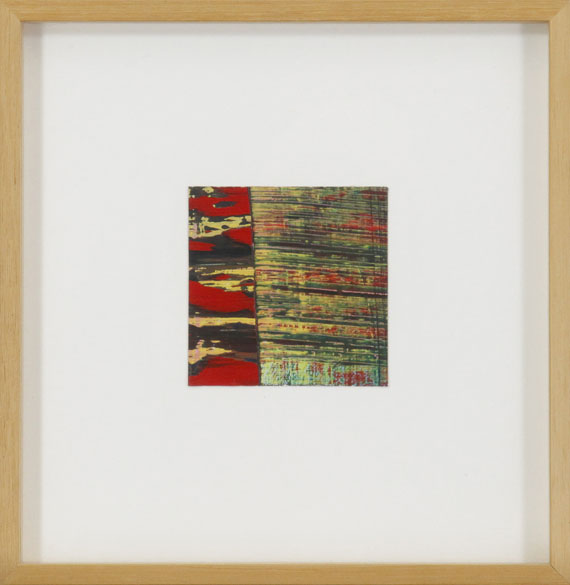101
Gerhard Richter
Miniaturen, 1996.
Oil on canvas, laid on cardboard
Estimate:
€ 30,000 / $ 32,100 Sold:
€ 53,340 / $ 57,073 (incl. surcharge)
Miniaturen. 1996.
Oil on canvas, laid on cardboard.
Butin 85 (Elger 838). Signed, dated and inscribed with the work number "838-20" on the reverse. From a series of 64 unique pieces. 7.9 x 7.9 cm (3.1 x 3.1 in). Backing board: 22 x 21,5 cm (8,6 x 8,5 in).
An "Abstraktes Bild" (1992, oil on canvas, catalogue raisonné Elger 767-6) is cut into pieces that then make up the series "Miniaturen" (Elger 838/1-64). They are identical with the edition no. 85. The works are mentioned in both catalogue rasionnés. [CH].
• Looking back on an artistic career that lasted for more than six decades, Gerhard Richter is one of the most important living artists today.
• From the work series "Miniaturen", which were cut from one of Gerhard Richter's paintings (Abstrakes Bild, 1992, Elger 767-6).
• Creation becomes subject to destruction to make way for a new aesthetic creation.
• Unique object.
PROVENANCE: Marian Goodman Gallery, New York.
Galerie Thomas von Lintel, Munich.
Private collection Southern Germany (acquired from the 1996).
LITERATURE: Hubertus Butin u. Stefan Gronert (ed.), Gerhard Richter. Editionen 1965-2004 (Catalogue Raisonné), Ostfildern 2004, cat. no. 85 (with illu. of a different copy).
Hubertus Butin, Stefan Gronert and Thomas Olbricht (ed.), Gerhard Richter. Editionen 1965-2013, Ostfildern 2014, cat. no. 85 (with illu. of a different copy).
Hubertus Butin, Gerhard Richter. Unikate in Serie, Cologne 2017, pp. 110f. (with illu. of a different copy, p. 115).
Hans-Jürgen Lechtreck, Original, Readymade, Edition, in: ex. cat. Gerhard Richter. Die Editionen, Museum Folkwang, Essen 2017, p. 26 (illu. of a different copy, p. 27).
Dietmar Elger, Gerhard Richter. Catalogue Raisonné 1994-2006, vol. 5 (no. 806-899-8), Ostfildern 2019, cat. no. 838 (with illu. of a different copy).
Oil on canvas, laid on cardboard.
Butin 85 (Elger 838). Signed, dated and inscribed with the work number "838-20" on the reverse. From a series of 64 unique pieces. 7.9 x 7.9 cm (3.1 x 3.1 in). Backing board: 22 x 21,5 cm (8,6 x 8,5 in).
An "Abstraktes Bild" (1992, oil on canvas, catalogue raisonné Elger 767-6) is cut into pieces that then make up the series "Miniaturen" (Elger 838/1-64). They are identical with the edition no. 85. The works are mentioned in both catalogue rasionnés. [CH].
• Looking back on an artistic career that lasted for more than six decades, Gerhard Richter is one of the most important living artists today.
• From the work series "Miniaturen", which were cut from one of Gerhard Richter's paintings (Abstrakes Bild, 1992, Elger 767-6).
• Creation becomes subject to destruction to make way for a new aesthetic creation.
• Unique object.
PROVENANCE: Marian Goodman Gallery, New York.
Galerie Thomas von Lintel, Munich.
Private collection Southern Germany (acquired from the 1996).
LITERATURE: Hubertus Butin u. Stefan Gronert (ed.), Gerhard Richter. Editionen 1965-2004 (Catalogue Raisonné), Ostfildern 2004, cat. no. 85 (with illu. of a different copy).
Hubertus Butin, Stefan Gronert and Thomas Olbricht (ed.), Gerhard Richter. Editionen 1965-2013, Ostfildern 2014, cat. no. 85 (with illu. of a different copy).
Hubertus Butin, Gerhard Richter. Unikate in Serie, Cologne 2017, pp. 110f. (with illu. of a different copy, p. 115).
Hans-Jürgen Lechtreck, Original, Readymade, Edition, in: ex. cat. Gerhard Richter. Die Editionen, Museum Folkwang, Essen 2017, p. 26 (illu. of a different copy, p. 27).
Dietmar Elger, Gerhard Richter. Catalogue Raisonné 1994-2006, vol. 5 (no. 806-899-8), Ostfildern 2019, cat. no. 838 (with illu. of a different copy).
Richter's famous "Abstract Pictures", were created with the squeegee - a wide wooden, rubber or aluminum spatula - in the 1980s, today they are the internationally most sought-after works of his painterly oeuvre. For the basic color scheme and as a compositional basis, the artist first creates a non-representational starting composition with a brush, which he then transforms into a veil of overlays and mixtures of colors with the help of a squeegee, thus lending it new, impressive aesthetics.
The work presented here combines the famous "Abstract Pictures" with a certain deconstruction or destruction: one of the "Abstract Pictures" is cut up into 64 individual parts, resulting in 64 smaller paintings. Richter's artistic process is often characterized by similar forms of destruction. In the "Abstract Pictures", the squeegee covers the underlying layers of paint, Richter paints over, scratches paint off and works it all over with a squeegee. In other paintings the artist works with blurring or paints over photographs or previously completed and then discarded images, as in the early series of the "Gray Pictures" in the 1960s. It’s like an artistic principle: something that has already been created is destroyed to make room for an aesthetic new creation. [CH]
The work presented here combines the famous "Abstract Pictures" with a certain deconstruction or destruction: one of the "Abstract Pictures" is cut up into 64 individual parts, resulting in 64 smaller paintings. Richter's artistic process is often characterized by similar forms of destruction. In the "Abstract Pictures", the squeegee covers the underlying layers of paint, Richter paints over, scratches paint off and works it all over with a squeegee. In other paintings the artist works with blurring or paints over photographs or previously completed and then discarded images, as in the early series of the "Gray Pictures" in the 1960s. It’s like an artistic principle: something that has already been created is destroyed to make room for an aesthetic new creation. [CH]
101
Gerhard Richter
Miniaturen, 1996.
Oil on canvas, laid on cardboard
Estimate:
€ 30,000 / $ 32,100 Sold:
€ 53,340 / $ 57,073 (incl. surcharge)




 Lot 101
Lot 101 
